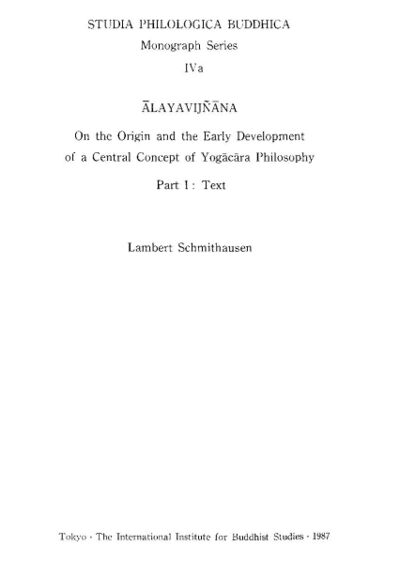Ālayavijñāna: On the Origin and the Early Development of a Central Concept of Yogācāra Philosophy. Part 1: Text
As is well known, one of the specific features of the philosophy of the Yogācāra school is the theory that in
addition to the traditional six kinds of mind, viz. the five sense-perceptions and non-sensory cognition (manovijñāna), there are two new, more or less subliminal forms, viz. kliṣṭa-manas and ālayavijñāna. The former is a continuous, subtle notion or feeling of 'I', whereas the latter, in accordance with the frequent Chinese rendering, i.e. "store mind," "connaissance-réceptacle, may, in a preliminary way, be characterized as the container or store-house of the latent residues or Impressions of previous actions (karman) and mind processes, or, following the usual Tibetan translation kun gźi rnam par śes pa ("fundamental mind", "Grunderkennen"), as the basic layer of mind processes or even the very basic constituent of the whole living being. It should be kept in mind that (at least in the "orthodox" Yogācāra school) ālayavijñāna is strictly person-bound, each living being having its own ālayavijñāna.
The present essay, though also including a few remarks on the origin of kliṣṭa-manas ( see § 7. 1A. 2. 2), is primarily concerned with the problem of the origin and development of ālayavijñana. Yet, my treatment of this matter is not exhaustive either. I have rather confined myself to dealing with the problem of the origin of ālayavijñāna in a rather limited sense (see § 1.4), and to an attempt to deduce, from my starting-point and the data available in the oldest materials, certain crucial aspects of the early development of this concept.
In accordance with the limited scope of the present essay, I
feel it justified to confine myself, as for previous research, to a short systematic outline of the essential aspects of what it has contributed to the question of the formation of the concept of ālayavijñāna (§ 1.3). Though I admit that a full account of the history of research on ālayavijñāna would be useful, it would take much more time than I can afford, and anyway it should, in view of the fact that most pertinent works are in Japanese, be written by a Japanese scholar. Nevertheless, apart from specific references in the notes, a few
recent theories on the origin of ālayavijñāana will be discussed in detail in § 7, because they advocate solutions considerably differing from mine, and because I should scarcely be justified in setting up a theory of my own if I did not give my reasons for not adopting one or the other of those already set forth.
As for the question of the origin of the concept of ālayavijñāna, the solution presented in this essay must remain a hypothetical one. In view of the fact that
even basic problems of the literary history of the older Yogācāra texts, esp. of the Yogācārabhūmi, are still unsolved or controversial and since some early materials are known only from fragments—and there may have been others no longer extant in explicit quotations—, statements on the early history of Yogācāra thought are almost inevitably, at least for the time being, bound to be hypothetical. But I think Suguro is right in emphasizing that we have no choice but to try to reconstruct the historical development of Yogācāra thought if we want to re-enact it, as it were, as a dynamic, living process, and not merely take stock of the
petrified (and often incoherent) results. Besides, even preliminary observations in terms of a history of ideas may, if handled with caution, on their part be helpful in resolving problems of literary history. But what I consider essential is that, even if we cannot (or cannot yet?), in our hypotheses on matters of the history of ideas (as well as of the literary history) of uncertain periods like early Yogācāra, reach certainty, we are none
the less clearly called upon to proceed from mere possibility or non-committal plausibility to probability; i.e. we should try to find out criteria which permit us to single out, from among the at times considerable number of possible explanations, the one which is (or at least those few which are) probable; and it is precisely this that I intend to do in the present essay. (Schmithausen, introductory, programmatic and methodological remarks, Vol. 1, 1–3)
(*Author's notes have been omitted)
| Citation | Schmithausen, Lambert. Ālayavijñāna: On the Origin and the Early Development of a Central Concept of Yogācāra Philosophy. Part 1: Text. Studia Philologica Buddhica Monograph Series 4a. Tokyo: International Institute for Buddhist Studies, 1987. |
|---|---|

